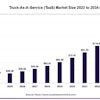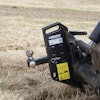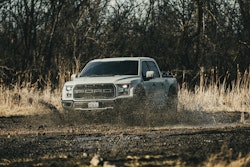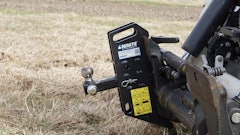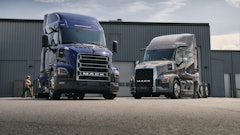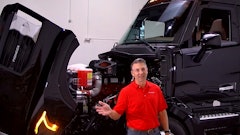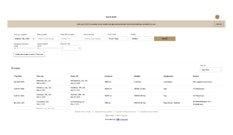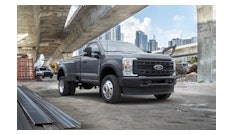The latest generation of pickups offer increased capacities in terms of payload, Gross Combined Weight Rating (GCWR), Gross Vehicle Weight Rating (GVWR), increased towing, more torque and higher horsepower. In many cases, these performance increases are accompanied by increased fuel efficiency, driver comfort and safety.
Such advancements are possible thanks to enhanced powertrains, stronger frames and improved suspension systems. The following highlights some of the more noteworthy features of 2010 and 2011 models.
Powertrain advancements
New engines, six-speed transmissions and advanced electronics translate into more horsepower, more torque and increased fuel economy.
Ford F-Series Super Duty pickups are built around the new 6.7-liter Power Stroke turbocharged diesel and 6.2-liter V-8 gasoline engines.
The Power Stroke diesel features a compacted graphite iron engine block to reduce weight and maximize strength; inboard exhaust and outboard intake architecture to reduce overall exhaust volume and increase throttle response; single-sequential turbocharger with a double-sided compressor wheel mounted on a single shaft; high-pressure fuel system that injects at more than 29,000 psi; and aluminum cylinder heads.
The result is an engine boasting 735 ft.-lbs. of torque at 1,600 rpm and 390 hp at 2,800 rpm. It has towing capacities of 24,400 lbs. and payload capacities to 6,520 lbs. To optimize performance and fuel economy while meeting exhaust emissions standards, Ford chose to use selective catalytic reduction (SCR), which requires the injection of diesel exhaust fluid (DEF) into the exhaust stream to reduce NOx emissions by more than 80%.
On the gasoline side, the company offers 405 ft.-lbs. of torque and 385 hp with its large bore, short stroke 6.2-liter V-8. The large 102mm bore allows for bigger intake and exhaust valves for improved engine breathing. The short 95mm stroke allows higher engine horsepower. This engine can run on regular-grade gasoline, E85 or any blend in between.
A six-speed TorqShift transmission was developed to handle all the torque the more powerful engines generate. Fuel economy is improved by the transmission's wider gear span, advanced controls that optimize the shift schedule, reduced parasitic friction losses and a lower-rpm torque converter lock up. When mated to the Power Stroke diesel, the transmission also features a live drive PTO. Power is available any time the engine is running to operate PTO devices.
Unlike its competition, the diesel engine-equipped Dodge Ram pickups will not require DEF fluid. The Cummins 6.7-liter turbo diesel engine uses exhaust gas recirculation (EGR) with a diesel particulate filter (DPF) to reduce particulate matter emissions and an absorber catalyst to reduce oxides of nitrogen. To accommodate the engine's cooling requirements, the grille opening is larger than the light-duty grille.
Cummins-equipped Ram 2500 and 3500 Heavy Duty pickups come with a standard diesel exhaust brake for improved brake life. These models are also available with six-speed manual transmissions.
Ram 1500 trucks have an interactive Decel Fuel Shut Off (iDFSO), which turns off the flow of fuel during vehicle deceleration for improved fuel economy without noticeable changes in engine performance.
For 2011, General Motors unveils a new Duramax 6.6-liter diesel engine and Allison 1000 six-speed automatic transmission, which enables an exhaust brake system. The enhanced transmission offers driver shift control with tap up/tap down shifting and an elevated idle mode cab warm-up feature. It has been strengthened to handle the higher torque capability of the new engine. Greater efficiency is delivered through reduced "spin loss," which means the transmission channels more of the engine's power to the axles.
The Duramax utilizes a 30,000-psi, high-pressure, Piezo-actuated fuel system for greater fuel efficiency, improved performance and reduced emissions. The engine pumps out 397 hp at 3,000 rpm and 765 lb.-ft. of torque at 1,600 rpm. An SCR aftertreatment system using DEF provides optimized diesel engine performance.
Frame and suspension upgrades
New frame offerings and suspension improvements translate into increased payload capabilities while maintaining ride quality.
General Motors developed 18 full-boxed frames for the 2011 Chevrolet Silverado and GMC Sierra pickups. The frames have increased cross sections and use more high-strength steel for greater durability, higher towing capacity and improved ride and handling. The fully boxed sections enhance torsional stiffness by a factor of five. Larger engine and transmission mounts, coupled with a 125% stiffer front frame structure, provide greater vibration control. Hydraulic body mounts are incorporated under the cab section on extended and crew cab models for a more isolated feel.
A redesigned independent front suspension system offers up to a 25% greater front axle weight rating (up to 6,000 lbs.), enabling a snow plow to be used on all 4WD cab configurations with the available snow plow prep package. The rear suspension is also designed to support greater loads. A larger rear leaf-spring design supports increased rear gross axle weight ratings across the board. The 2500HD models are rated up to 6,200 lbs., while the 3500HD models are rated up to 7,050 lbs. on single-rear-wheel and 9,375 lbs. on dual-rear-wheel configurations.
GM increased the diameter if its brake rotors to 14 in. on all models to support the increased capacity, weight ratings and trailer ratings. The calipers are also stiffer and stronger for reduced pedal travel and improved pedal feel.
For 2011, Ford optimized the frame and suspension of the current Super Duty. Changes were made to the leaf springs and spring rates, as well as the internal valving in all of the shock absorbers to enable greater towing and payload capability. The 4x2 F-250 and F-350 Super Duty feature a modified steering system geometry to better take advantage of the twin-beam suspension.
The 2010 Ram Heavy Duty pickups have a hydro-formed, fully boxed frame with advanced torsional rigidity and stiffness. A coil-spring suspension is used up front, while the multi-leaf spring design is maintained in the rear. Improved suspension tuning and new C-pillar hydro mounts were added to improve damping through the frame-bending mode frequency in order to better manage shake and after-shake response.
Electronics improve control
Electronics continue to evolve, improving operator safety and trailer towing performance. All of the trucks discussed here come with advanced electronics, such as a tow/haul mode and electronic range select to enable the driver to manually limit the highest available transmission gear. In addition, they all allow the driver the capability to manually select and shift the transmission gears.
There are other electronic enhancements available, as well. Ford equips all pickups with a Trailer Sway Control (TSC) system. TSC is integrated with AdvanceTrac with Roll Stability Control, which is standard on all single-rear-wheel configurations. Software monitors the truck's motion when a trailer is attached. It can determine from the yaw motion of the truck if the trailer is swaying and take action (e.g., apply precise braking or reduce engine torque) to reduce trailer sway.
Ford also offers hill start assist, which applies brakes to prevent rollback, and hill descent control, which uses the accelerator and brake to set and hold the speed when descending steep grades. An electronic locking differential provides maximum traction by forcing the rear wheels to turn at the same speed.
General Motors also offers an array of control features, including trailer sway control, integrated trailer brake control, hill start assist, automatic grade braking and intelligent brake assist. The trailer sway control system senses sway conditions and intervenes with braking and/or reduced engine power to bring the trailer under control. This system requires no input from the driver.
The hill start assist system automatically engages when sensors detect the vehicle is on a grade of roughly 5% or greater. It holds the brakes for about 1.5 seconds until the gas pedal is pressed.
Ram trucks offer an integrated trailer brake controller that provides better driver control in towing situations. Trailer brake control information is displayed in the Electronic Vehicle Information Center (EVIC), which is standard on all diesel-equipped Ram Heavy Duty models and available on gas SLT, TRX and Laramie models.
Cab offerings expand
There are a couple new cab configurations available with the newest generation of pickups.
For the first time, the 2010 Ram Heavy Duty is available in a crew cab. This is the highest volume portion of this market, representing approximately 50% of the heavy-duty pickups sold.
General Motors also rolls out the new GMC Sierra Denali HD. This truck comes exclusively on the 2500HD chassis in a 4WD crew cab standard box configuration. Also new for 2011 is the 3500HD crew cab with a 6-ft. 6-in. bed for increased cargo capacity, and the return of a 2WD 3500HD regular cab with dual rear wheels.
As you can see, the pickup market is anything but business as usual. The major OEMs have stepped up to the plate to offer increased capability with reduced operating cost - not a small feat!

